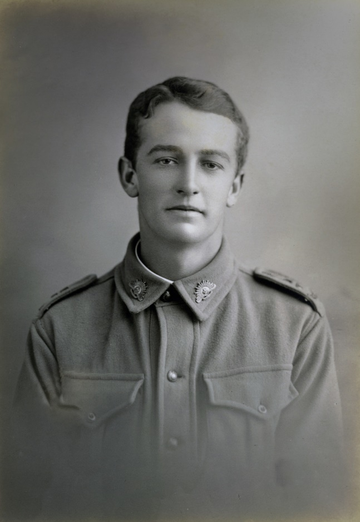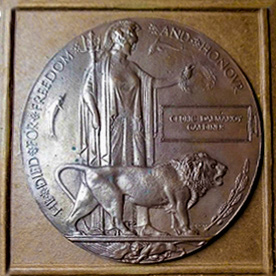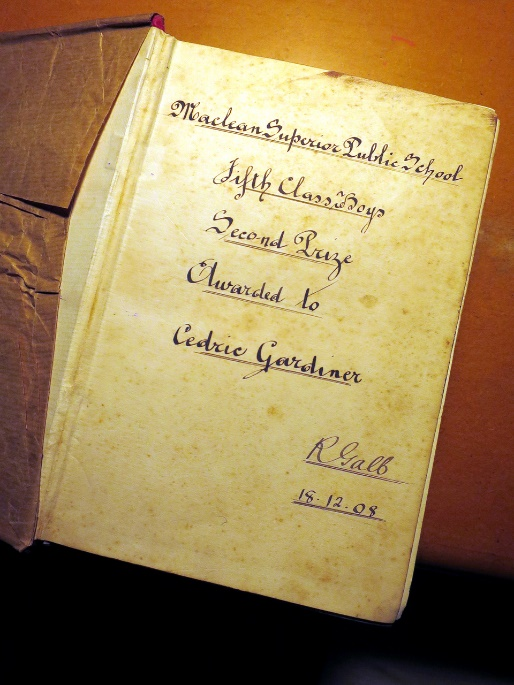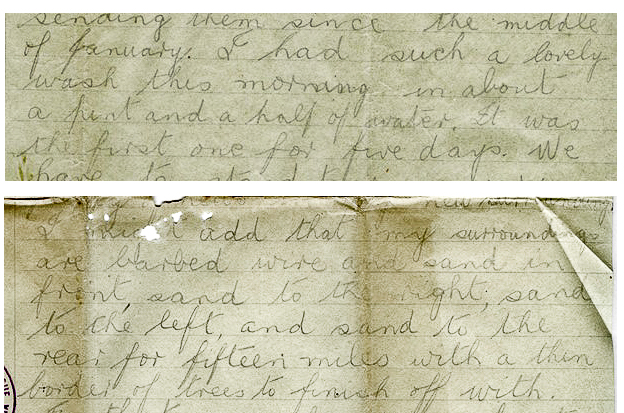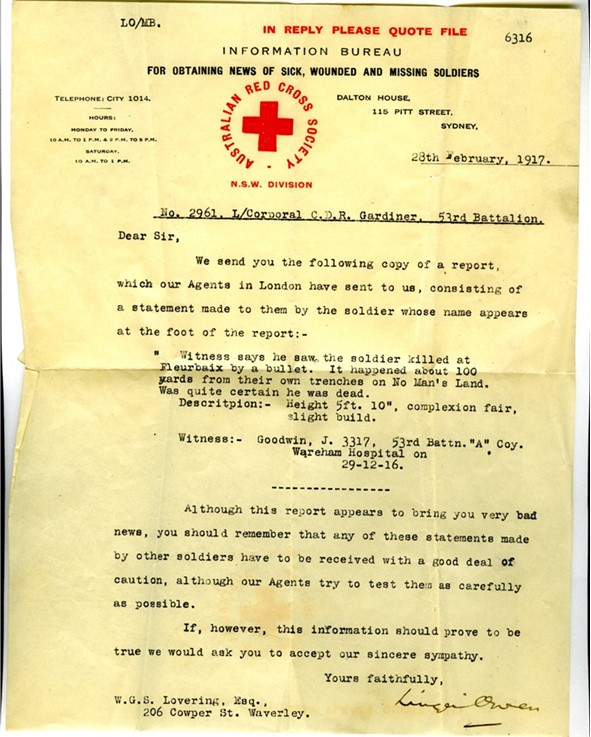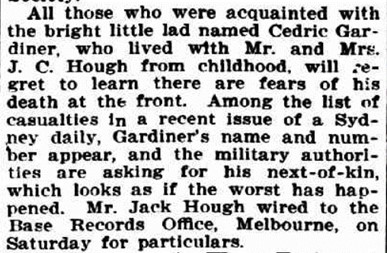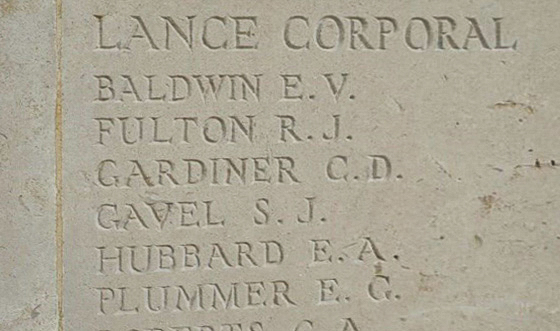Cedric Dalmahoy Russell GARDINER
Eyes grey, Hair brown, Complexion fresh
“Goodbye for the present.” – The Story of Cedric Gardiner
With thanks to relative Eric Sierins and historian Greg Towner for their contribution to this story and for providing the letters from Ced that are cited in his story below.
(Editorial note - This story about a WW1 soldier, his family and his ancestors is familiar in how it unfolds and Ced’s letters home capture a young soldier’s progression from the bravado at enlistment, to anticipating and experiencing the adventures that awaited him and finally to grasping what he was about to enter into, although still through a youthful view of the world.)
Can you help us identify Ced?
Cedric Dalmahoy Russell Gardiner was killed in Action at Fromelles. As part of the 53rd Battalion he was positioned near where the Germans collected soldiers who were later buried at Pheasant Wood. There is a chance he might be identified, but we need help. We are still searching for suitable family DNA donors.
In 2008 a mass grave was found at Fromelles, a grave the Germans dug for 250 (Australian) bodies they recovered after the battle.
If you know anything of contacts here in Australia or his relatives from New Zealand or Scotland, please contact the Fromelles Association.
See the DNA box at the end of the story for what we do know about his family.
‘Discovering’ Ced – Eric Sierins
Cedric Dalmahoy Russell Gardiner was my first cousin once removed. When in aged care and a couple of years before my mother died in 2017, she mentioned to me that there was a relative who had died - at Gallipoli, she said. She was misinformed about this, as was all of the family. Further she said that I should look out for a medallion with name Cedric on it.
Unfortunately my mother was a hoarder, so there were plenty of places, boxes etc to start looking in. Eventually I found the medallion in a box in the house and later in the clean-up of the two-car garage I found a grey David Jones dry cleaning box with words ‘Papers to be disposed of’ written in Texta across the top. Just like everything that came into my mother’s possession, they hadn’t been ‘disposed of’. Nothing had ever been disposed of by my mother.
So I had found the British Invasion Forces medallion and with it Ced’s full name of Cedric Dalmahoy Gardiner.
And in 1915 Ced did indeed enlist and prepare for war. I can’t now remember being 18 years old and certainly I can’t imagine being 18 and deciding that the best decision for the next part of my life would be to enlist and prepare for war. Cedric Dalmahoy Russell Gardiner had decided with so many others to do just that.
Ced’s Family
Cedric Dalmahoy Russell Gardiner was born in January 1896 at Minyip, Victoria to Dalmahoy and Louisa Alvina Maude (nee Russell) Gardiner. Dalmahoy and Louisa were married in 1895, at Minyip, north-west of Ballarat, Victoria. Ced appears to have been an only child. Little could be found on Dalmahoy Gardiner, other than he was a caterer and confectioner. It is not surprising then when Cedric enlisted he gave his occupation as a confectioner. Ced and his father changed the spelling of Dalmohy to Dalmahoy to presumably reflect the way the name was pronounced.
The name Dalmahoy has Scottish antecedents. Maybe he was from Canada (which was a memory from my Aunty June). He could too have come to Australia from New Zealand. I only mention this because he went there with my grandmother, Gladys (in mourning of Cedric’s death) for some sort of relaxing holiday. Later, Dalmahoy’s estate was auctioned in Wellington, in 1919.
Ced’s family of three moved to Sydney, where his mother Louisa died of appendicitis in 1902. It must have been a tragic circumstance as Ced was left motherless at age six. Subsequently, Ced was brought up at Ashby, near Maclean, New South Wales, living with Mr John C Hough and his wife Matilda. He attended High School in Maclean. We know this because of the inscription inside the prize of a book he won at - Maclean Superior Public School, Fifth Class Boys, Second Prize Awarded to Cedric Gardiner by R Galb on 18 December 1908.
Ced also made an impression on the residents of the district, as seen in the following two items from a local paper on 9th March 1910:
Cedric Gardiner, a lad employed by Mr J.C. Hough of Ashby, had one of his arms broken last week through a milk cart that he was driving being overturned.
And again on the 13 September 1916:
All those who were acquainted with the bright little lad named Cedric Gardiner, who lived with Mr. & Mrs. J.C. Hough from childhood, will regret to learn there are fears of his death at the front.
Because of the extended nature of his mother’s Russell family, Cedric was a mere year younger than his aunt, Gladys. Gladys must have been the one person he could talk to in a sea of old people and she was the one he mostly wrote to while overseas.
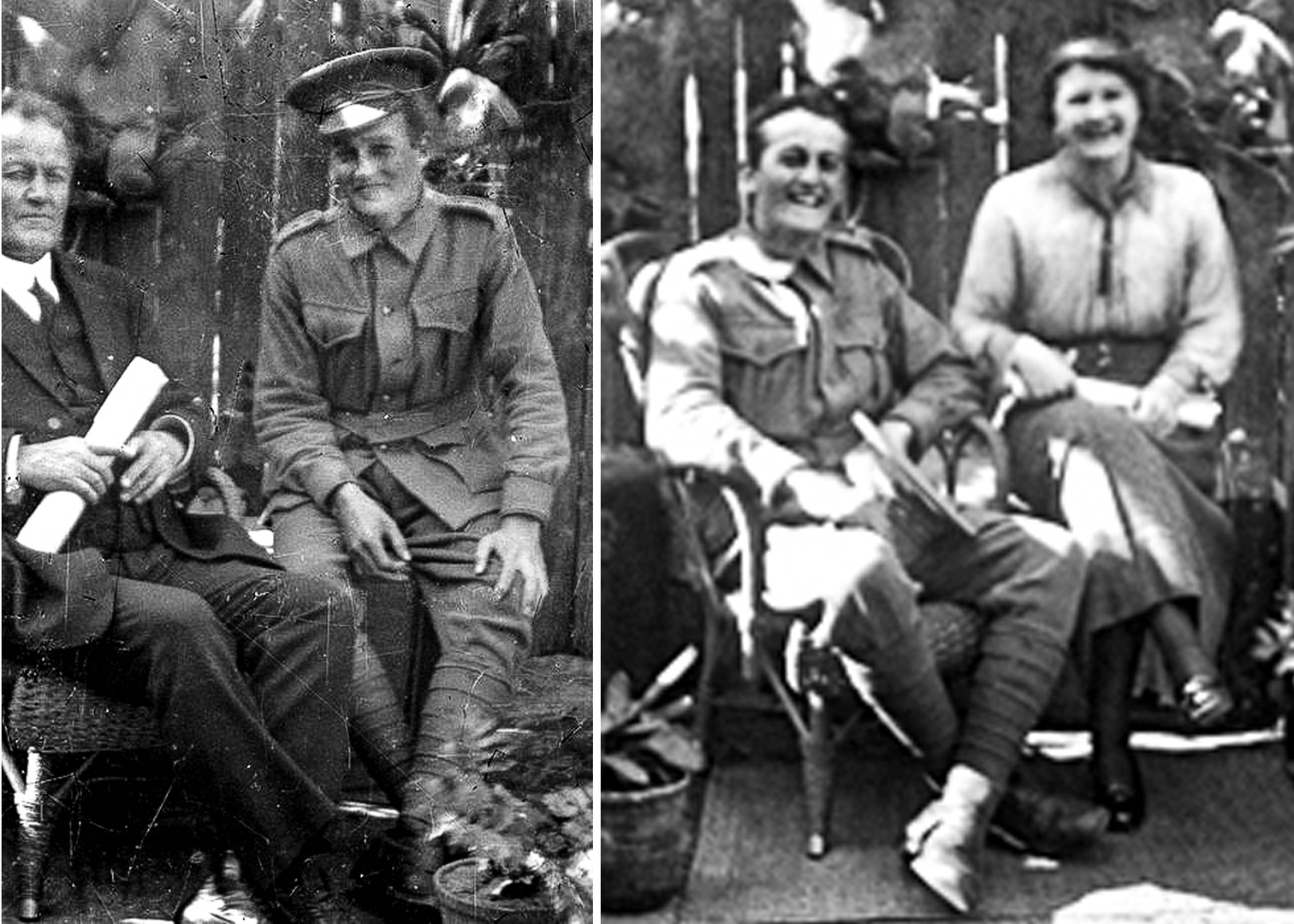
Before he departed for the War, he had become engaged to Miss Evelyn (Lyn) Burke from Paddington. Dalmahoy and Ced had previously stayed in the house of the Burke family.
Off to War
At just 18 years old, Ced enlisted in Sydney on 3 August 1915 and was assigned to the 1st Battalion, 9th reinforcements. At the time, he was living with his Aunt Ethel and her husband William Lovering. After a very brief period of military training, Ced embarked from Sydney on 30 September 1915 on HMAT Argyllshire , headed for Egypt. In a letter to his Aunt Gladys on 1 October, he exuded confidence in his future (an oft-stated belief by the new soldiers):
“Don’t worry over me dear because I’ll be a safe as a bank.”
After arriving in Egypt, training was continued at the large camp at Tel-el-Kebir camp, not far from Cairo. While there was hard work, the location also offered the adventure many young soldiers were seeking.
“We disembarked, and marched to camp, and we were then shown our barracks, and we took off our equipment and were dismissed.” “We didn’t wait for tea, but went for the tram, and went to Cairo, which is about seven miles away.” “We had a great time around the city eating, drinking and making merry.”
“There were some establishments there such as Cairo Wazir that I had no idea could exist.” ”There are also a lot of donkey boys about, and it’s great to get on a donkey, and gallop for your life along the street, cheering for all that your (sic) worth.”
Such adventures aside, with all the new recruits from Australia arriving in Egypt, major reorganizations were underway as the AIF expanded from two infantry divisions to five and Ced was transferred to the newly formed 53rd Battalion, A Company on 13 February 1916. The 53rd Battalion was formed from 1st Battalion Gallipoli experienced soldiers and new recruits from Australia.
The Gallipoli soldiers were not slow in pointing out to whoever would listen that they were the ‘Dinkums’ and the new recruits were the ‘War Babies’, which Ced confirms in a letter home.
In March they were sent to Ferry Post, on foot, a trip of about 60 km that took three days. It was a significant challenge, walking over the soft sand in the 38°C heat with each man carrying their own possessions and 120 rounds of ammunition. Many of the men suffered heat stroke.
From a 27 March letter, Ced confirms that it was an arduous trip:
“but now the sand became deeper and everyone knows how distressing sand is under normal conditions, but when it means a march carrying between sixty and seventy pounds, it taxes human endurance to the utmost.
The Brigade was at the time of halting for the mid-day meal, showing very evident signs of distress, and water was very scarce.
The heat was even greater than the day before, and to add to our tortures a very fine white dust thrown up by the moving feet of marching men, entered our nostrils, ears and formed a hard dry caking of mud in the mouth.
The journey continued through the afternoon and after almost indescribable hardships in which Australian endurance was strained to a breaking point, Moascar was reached.”
While at Ferry Post, guarding the Suez Canal, on 8 May 1916 Ced was promoted to Lance Corporal. Conditions in Egypt continued to be a challenge:
“I had such a lovely wash this morning in about a pint and a half of water. It was the first one for five days.”
“I must add that my surroundings are barbed wire and sand in front, sand to the right, sand to the left, and sand to the rear for fifteen miles with a thin border of trees to finish off with.”
On 16 June they began the move to the Western Front and on 19 June 32 officers and 958 soldiers of the 53rd left Alexandria on the Royal George, bound for Marseilles, France. Earlier, Ced had written - ‘All the chaps here, are simply dying to get to the front to have a go at the Huns.’ – they were now on their way.
The 53rd arrived in Marseilles on 28 June and were put on trains for a 62 hour ride to Hazebrouck before marching into the camp at nearby Thiennes.
While glad to be out of Egypt and marveling at his first experience of France, the reality of what he was soon to be in for seems to have finally sunken in:
“Treading on French soil for the first time was a moment of excitement.”
“By jove, the trip on the train was lovely. The scenery was simply beautiful. All the farms of different coloured crops, divided by hedges, and with lovely avenues running through, and the mountains in the background, it was a picture to be remembered.”
“The fields mainly had older people tending to crops. The young and fit must have been at the war.”
“At one point we stopped beside a Red Cross train crammed full of the wounded. We could talk to them if they were not too badly wounded but there was a certain look in their eyes that spoke powerfully of the sadness and loss of the conflict. The atmosphere of wonder and experiencing the world became soured and as we headed further north a quiet fell over most of the carriage.”
On 8 July they began a 30 km march to Fleurbaix, settled into billets there and soon were into the trenches. On 10 July he wrote:
“We changed over with some troops in the trenches at 9 pip-emma (pm) at Fleurbaix and it did seem quiet enough. Then the war was real.”
“We were given parts of the trench to guard. Looking for gas bombs and waiting with a feeling of such expectation. I could see my fellow soldiers down the trench line, but I was more or less alone.”
“One fellow nearby me seemed to be doing nothing and so I asked him what he was doing. Look through this he said. And I looked through this piece of metal that had a mirror in it and all of a sudden I could see the German front line across no-man’s land. It looked like a garbage tip with weeds and rubbish everywhere and masses of rusted barbed wire…
So this was the Western Front and all was quiet.”
Ced’s last letter was on 14 July. Even given his situation, he remained youthfully optimistic for what he was about to go through.
“By jove the star shells are lovely at night here.”
“Goodbye for the present.“
“Fond love to Sid, Ethel and yourself. Send my love to Grandma”
Cedric Gardiner Letter 14th July 1916 - Courtesy of Eric Sierins
Into Battle

Early the next morning, the 53rd were moved straight into the front lines for an attack, but it was cancelled due to bad weather. They remained in the trenches in relief of the 54th.
On the 19th, heavy bombardment was underway from both armies by 11 AM. At 4 PM the 54th rejoined in the trenches on their left. All were now in position for battle. The main objective for the 53rd was to take the trenches to the left of a heavily armed, elevated German defensive position, the ‘Sugar Loaf’, which dominated the front lines. If the Sugar Loaf could not be taken, the 53rd and the other battalions would be subjected to murderous enfiled fire from the machine guns and counterattacks from that direction. As they advanced, the 53rd were to link up with the 60th and 54th Battalions on their flanks.
The soldiers had been briefed earlier on the objectives. Per Ced’s 10 July letter:
“The talk was all about the stunt that we were there for. Other battalions were being paraded and addressed by the colonel in charge. They marched, wheeled, lined up and sloped arms, then ordered arms and stood to attention. Their colonel stood in front of them, facing them and said, ‘Stand at ease’.
He began to explain the plans of the attack our division was to participate in that night. He was telling them in a less formal way that this was the first AIF battle in France. We must strive to succeed. Our orders were to take 2 lines of German trenches and hold them at all cost. We must hold them and good luck.”
The Australians went on the offensive at 5.43 PM. They moved forward in four waves – Ced’s A Company and B Company were in the first two waves and C & D were in the third and fourth. They did not immediately charge the German lines, but went out into No-Man’s-Land and laid down, waiting for the British bombardment to lift. At 6 PM the German lines were rushed. The 53rd were under heavy artillery, machine gun and rifle fire, but were able to advance rapidly. Corporal J.T. James of C Company (3550) reported:
“At Fleurbaix on the 19th July we were attacking at 6 p.m. We took three lines of German trenches”
The 14th Brigade War Diary notes that the artillery had been successful and “very few living Germans were found in the first and second line trenches”, BUT within the first 20 minutes the 53rd lost ALL the company commanders, ALL their seconds in command and six junior officers.
Source: AWM C E W Bean, The AIF in France, Vol 3, Chapter XII, pg 369
It is likely that Ced was killed in this first onslaught - killed by a bullet about 100 yards into No-Man’s-Land - based on a Red Cross witness statement from Jesse Goodwin (3317), who was also in A Company with Ced.
The 53rd were able to link up with the 54th on their left and, with the 31st and 32nd, occupy a line from Rouges Bancs to near Delangre Farm, but the 60th on their right had been unable to advance due to the devastation from the machine gun emplacement at the Sugar Loaf. They held their lines through the night against “violent” attacks from the Germans from the front, but their exposed right flank had allowed the Germans access to the first line trench BEHIND the 53rd, requiring the Australians to later have to fight their way back to their own lines. By 9.00 AM on the 20th July, the 53rd received orders to retreat from positions won and by 9.30 AM they had “retired with very heavy loss”.
Source: AWM4 23/70/2 53rd Battalion War Diaries July 1916 page 7
Of the 990 men who had left Alexandria just weeks before, the initial count at roll call was 36 killed, 353 wounded and 236 missing.
“Many heroic actions were performed.”
Source: AWM4 23/70/2 53rd Battalion War Diaries July 1916 page 8
To get some perspective of the battle, when Charles Bean, Australia’s official war historian, attended the battlefield two and half years later, he observed a large amount of bones, torn uniforms and Australian kit still on the battlefield. The final impact of the battle on the 53rd was that 245 soldiers were killed or died from their wounds and, of this, 190 were not able to be identified. In 2008 a mass grave dug by the Germans was discovered that contained 250 bodies. As of 2024, 15 of the unidentified soldiers from the 53rd have been found in this grave thru DNA matching from family members. 80 of the 250 soldiers remain unidentified from the grave.
Back at Home
Ced’s father was advised Ced was among the missing after the battle and the word spread.
His fiancé Lyn and his extended family made a number of enquiries, trying to find out what had happened to him. Unfortunately, the Army had little that they could offer. Ced’s Aunt Ethel’s husband, William Lovering, also contacted the Red Cross and received the 27 February 1917 witness statement about Ced having been shot about 100 yards from the Australian lines. A Court of Inquiry in the Field on 2 September 1917 formally declared that Ced had been killed in action.
After it was confirmed that Ced was lost to the war, his father and his Aunt Gladys, in shared grief, took a trip to New Zealand. Dalmahoy passed away in 1919. Ced was awarded the Victory Medal, the British War Medal, a Memorial Plaque and a Memorial Scroll.
He is commemorated at:
- VC Corner, Panel 7, Australian Cemetery Memorial Fromelles France
- the Australian War Memorial, Panel 157, Canberra
- The Maclean Public School Honour Board.
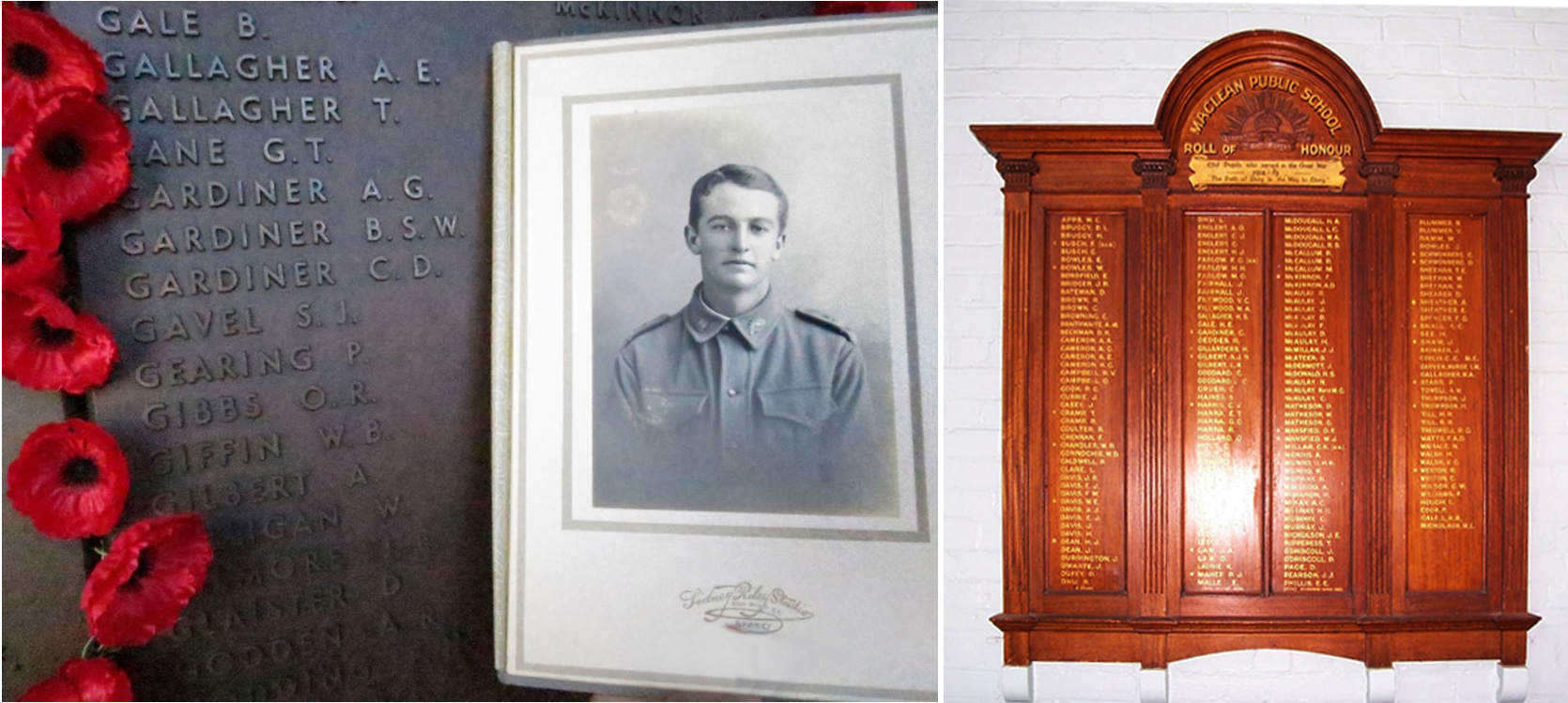
Could Ced be ‘re-discovered’?
According to Eric, evidently very little was ever said about Cedric in the family after the War:
“In fact, so little was said in the family that my mother, Shirley, and her sister, June, both were under the illusion that Cedric had died at Gallipoli and not in a later battle.”
There is still hope to properly rediscover Ced, however. The mass grave at Pheasant Wood dug by the Germans still has 70 unidentified soldiers in it. Fifteen soldiers from the 53rd have been found in the grave through DNA testing from family donors. One of these remaining soldiers could be Ced. We need DNA donors to know. If you know anything of Ced’s Y/male DNA (Campbell?) or mt/Female DNA (Gardiner ) lines here in Australia or possibly from New Zealand or Scotland we would like to hear from you.
DNA samples are being sought for family connections to
| Soldier | Cedric Dalmahoy Russell Gardiner (1896-1916) |
| Parents | Dalmohy/Dalmahoy Gardiner (1869 - 1919).. d Sydney NSW and Louisa Alvina Maud Russell (1875 - 1902) b Buninyong VIC d Sydney NSW |
| Grandparents | |||
| Paternal | Dalmahoy Colin Campbell (1843-1897) and Isabella Gardiner (1843-1892), Co Tyrone-Singleton NSW | ||
| Maternal | Louis Russell (1851-1901) b Germany and Alice Marion Turner (1855 - 1933) |
Note. Cedrics father Dalmohy is reported to have been born Sydney NSW (Marriage Certificate) , however no Birth Certificate has been located to verify this as fact to date (Feb 2024)
Seeking DNA Donors

Contacts
(Contact: carla@fromelles.info or geoffrey@fromelles.info).
(Contact: army.uwc@defence.gov.au or phone 1800 019 090).
Donations
If you are able, please contribute to the upkeep of this resource.
(Contact: bill@fromelles.info ).
